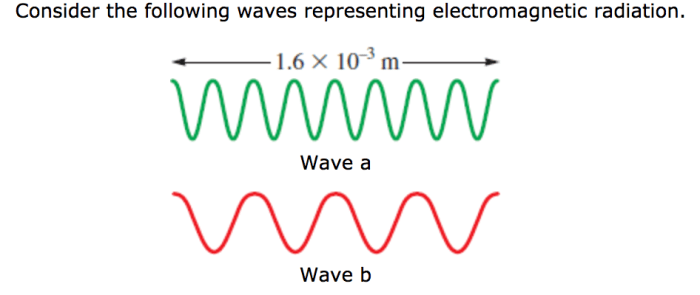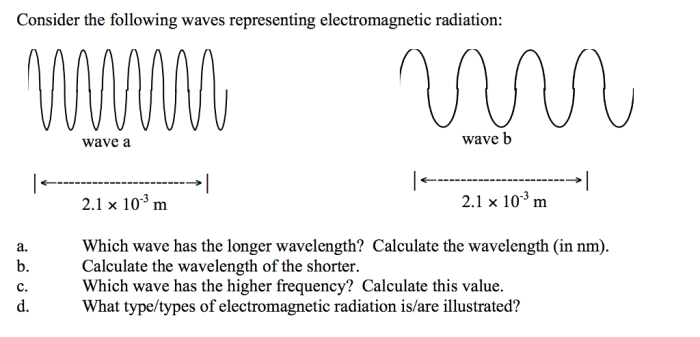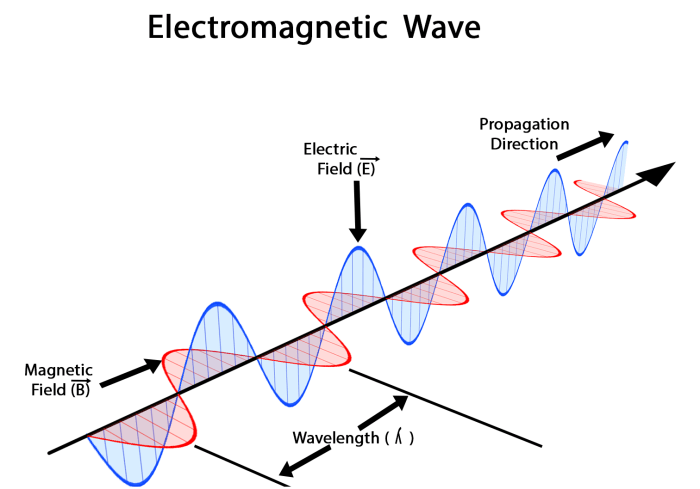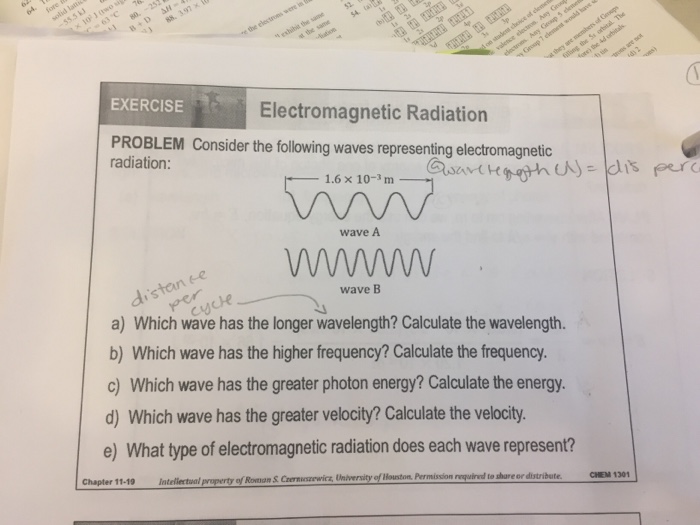Consider the following waves representing electromagnetic radiation: radio waves, microwaves, infrared radiation, visible light, ultraviolet radiation, X-rays, and gamma rays. These waves, arranged in order of increasing frequency and energy, form the electromagnetic spectrum, which encompasses the entire range of electromagnetic radiation.
Electromagnetic waves are a fundamental part of our universe, playing a vital role in everything from communication to medicine to the very nature of light itself. By understanding the properties and applications of electromagnetic waves, we gain a deeper appreciation for the intricate workings of our world.
Electromagnetic Spectrum
The electromagnetic spectrum encompasses a vast range of electromagnetic waves characterized by their frequency, wavelength, and energy levels. These waves exhibit diverse properties and applications across various domains.
Table: Electromagnetic Spectrum
| Type | Frequency (Hz) | Wavelength (m) | Energy (J) |
|---|---|---|---|
| Radio Waves | 103
|
10-1
|
10-23
|
| Microwaves | 109
|
10-3
|
10-21
|
| Infrared Radiation | 1012
|
10-6
|
10-19
|
| Visible Light | 1014
|
4 x 10-7
|
10-19
|
| Ultraviolet Radiation | 1015
|
10-8
|
10-18
|
| X-rays | 1016
|
10-11
|
10-15
|
| Gamma Rays | >1020 | <10-11 | >10-10 |
Properties of Electromagnetic Waves

Electromagnetic waves possess fundamental properties that influence their behavior and applications. These properties include:
Frequency, Consider the following waves representing electromagnetic radiation
Frequency refers to the number of oscillations per second and is measured in Hertz (Hz). Higher frequency waves have shorter wavelengths and higher energy.
Wavelength
Wavelength is the distance between two consecutive crests or troughs of a wave and is measured in meters (m). Shorter wavelengths correspond to higher frequencies and higher energy.
Amplitude
Amplitude measures the maximum displacement of a wave from its equilibrium position and determines its intensity or brightness.
Polarization
Polarization describes the orientation of the electric field vector in an electromagnetic wave and can be linear, circular, or elliptical.
Applications of Electromagnetic Radiation

Electromagnetic radiation finds applications in a wide range of industries and domains, including:
- Communication:Radio waves, microwaves, and infrared radiation are used for wireless communication, such as mobile phones, Wi-Fi, and satellite communication.
- Medicine:X-rays and gamma rays are used for medical imaging and cancer treatment, while microwaves are used in surgical procedures.
- Imaging:Infrared cameras are used for thermal imaging, while ultraviolet radiation is used in spectroscopy and astronomy.
- Industry:Microwaves are used in food processing, while ultraviolet radiation is used in sterilization and curing.
- Research:Gamma rays are used in nuclear physics research, while visible light is used in optics and laser technology.
Interactions with Matter

Electromagnetic waves interact with matter in various ways, including:
Absorption
Absorption occurs when electromagnetic waves are absorbed by matter, converting their energy into heat or other forms of energy.
Reflection
Reflection occurs when electromagnetic waves bounce off a surface, changing their direction of propagation.
Refraction
Refraction occurs when electromagnetic waves pass from one medium to another, causing their direction of propagation to change.
Diffraction
Diffraction occurs when electromagnetic waves encounter an obstacle or aperture, causing them to spread out and bend around the obstacle.
Wave-Particle Duality
Electromagnetic radiation exhibits wave-particle duality, meaning it possesses both wave-like and particle-like properties.
As waves, electromagnetic radiation exhibits interference and diffraction patterns. As particles, known as photons, they carry discrete amounts of energy proportional to their frequency.
Emerging Technologies

Emerging technologies utilizing electromagnetic waves include:
- Wireless Power Transfer:Transferring power wirelessly using electromagnetic fields.
- Metamaterials:Artificial materials engineered to control electromagnetic waves in novel ways.
- Quantum Computing:Utilizing the wave-particle duality of photons for quantum information processing.
FAQs: Consider The Following Waves Representing Electromagnetic Radiation
What is the difference between electromagnetic waves and sound waves?
Electromagnetic waves are transverse waves that do not require a medium to propagate, while sound waves are longitudinal waves that require a medium to propagate.
What is the speed of electromagnetic waves?
Electromagnetic waves travel at the speed of light, which is approximately 3 x 10^8 meters per second.
What are the different applications of electromagnetic waves?
Electromagnetic waves have a wide range of applications, including communication, medicine, imaging, and power transmission.